Water Yield Alteration in Thailand’s Pak Phanang Basin Due to Impacts of Climate and Land-Use Changes
Abstract
:1. Introduction
2. Materials and Methods
2.1. Description of the Study Area
2.2. Data Used in the Study of the SWAT Model
- Digital Elevation Model (DEM) data are from a topographical database that shows the elevation of a watershed area, which is obtained from altitude or elevation points. The data can be stored, processed, and presented in models in various formats. In this study, a geographic reference system (WGS 1984 UTM Zone 47 N) with a resolution of 5 m was used for raster data (Figure 3a).
- LULC data were collected from the Land Development Department in 2007 and 2018, and were used to study past and present land-use projections. The CA-Markov model was used to study future land-use changes. Land use was divided into different areas (e.g., forest, agriculture, accommodation, and water resources), and the information obtained must have characteristics that can be used in reclassifying to the ArcSWAT database suite by SWAT code (Figure 3b).
- Data of Soil map were collected from the Department of Land Development. The data revealed that there were 13 soil series in the study area. Most of the soil series is soil-5, moderately fertile clay soil with poor drainage, followed by soil-16 with moderate fertility and loamy soil with poor drainage. The slope compact of the watershed is shallow soils with rocky or plain rocks found, in which the soil fertility is very low, which is soil-24. In addition, soil-3 with rubble, and gravel were mixed in the soil layer from good to poor drainage and low soil fertility. Soil-6 is loamy soil; it has poor drainage and moderate soil fertility. Soil-9 is loamy soil with good to moderate drainage and moderate soil fertility. In addition, soil-2, -7, -11, -13, -17, -18, and -23 are a minority of the total area. Soil series data need attributes that can be used in reclassifying to the ArcSWAT database as shown below (Figure 3c).
- Hydrological data using data on daily runoff-rainfall were collected from the Hydrology and Water Management Center 2008–2018, namely Ban Sao Thong Station (X.167), Ron Phibun District, Nakhon Si Thammarat Province. It has a total catchment area of 251.99 km2 at latitude of 8.1644 and longitude of 99.5430.
- Watershed dataset and stream database were prepared with shapefile and ArcSWAT on the Watershed Delineation step, and link its attributes to watershed file when using the predefined watershed and stream layers in ArcSWAT 2012.
- Meteorological data for 2006–2019 using the highest–lowest temperature data were collected from three stations, namely Pak Phanang Station at latitude of 8.3571 and longitude of 100.1981, Chian Yai Station at latitude of 8.0851 and longitude 100.1324, and Lan Saka Station at latitude 8.3403 and longitude 99.8281. The locations of the climate measurement stations have been provided in a table file in text format (*.txt). The climatic data used consists of daily precipitation data and maximum–minimum temperature data.
2.3. Land-Use/Land-Cover Change in the Pak Phanang River Basin
2.4. Generation of Weather Data
2.5. Performance Evaluation Methods
3. Results and Discussions
3.1. SWAT Analysis and Performance of the SWAT Model
3.2. SWAT Calibration and Validation
3.3. LULC Change in the Pak Phanang River Basin
3.4. Effects of Climate Change on Future Runoff
4. Conclusions
Author Contributions
Funding
Institutional Review Board Statement
Informed Consent Statement
Data Availability Statement
Acknowledgments
Conflicts of Interest
References
- Rogério de Mello, C.; Norton, L.D.; Pinto, L.C.; Beskow, S.; Curi, N. Agricultural watershed modeling: A review for hydrology and soil erosion processes. Cienc. Agrotecnologia 2016, 40, 7–25. [Google Scholar] [CrossRef] [Green Version]
- Vereecken, H.; Huisman, J.A.; Hendricks Franssen, H.J.; Brüggemann, N.; Bogena, H.R.; Kollet, S.; Javaux, M.; van der Kruk, J.; Vanderborght, J. Soil hydrology: Recent methodological advances, challenges, and perspectives. Water Resour. Res. 2015, 51, 2616–2633. [Google Scholar] [CrossRef]
- Piao, S.; Ciais, P.; Huang, Y.; Shen, Z.; Peng, S.; Li, J.; Zhou, L.; Liu, H.; Ma, Y.; Ding, Y.; et al. The impacts of climate change on water resources and agriculture in China. Nature 2010, 467, 43–51. [Google Scholar] [CrossRef] [PubMed]
- Kusangaya, S.; Warburton, M.L.; Van Garderen, E.A.; Jewitt, G.P. Impacts of climate change on water resources in southern Africa: A review. Phys. Chem. Earth Parts A B C 2014, 1, 47–54. [Google Scholar] [CrossRef]
- Wang, H.; Khayatnezhad, M.; Youssefi, N. Using an optimized soil and water assessment tool by deep belief networks to evaluate the impact of land use and climate change on water resources. Concurr. Comput. Pract. Exp. 2022, 34, e6807. [Google Scholar] [CrossRef]
- Ortegón, Y.A.; Acosta-Prado, J.C.; Acosta Castellanos, P.M. Impact of Land Cover Changes on the Availability of Water Resources in the Regional Natural Park Serranía de Las Quinchas. Sustainability 2022, 14, 3237. [Google Scholar] [CrossRef]
- Daba, M.H.; You, S. Quantitatively assessing the future land-use/land-cover changes and their driving factors in the upper stream of the Awash River based on the CA–markov model and their implications for water resources management. Sustainability 2022, 14, 1538. [Google Scholar] [CrossRef]
- Letta, M.; Tol, R.S.J. Weather, Climate and Total Factor Productivity. Tour. Manag. Perspect. 2019, 5, 51–56. [Google Scholar] [CrossRef] [Green Version]
- Absalon, D.; Ślesak, B. Air temperature increase and quality of life in an anthropogenically transformed environment: A case study. Pol. J. Environ. Stud. 2012, 21, 235–239. [Google Scholar]
- Nastos, P.T.; Matzarakis, A. The effect of air temperature and human thermal indices on mortality in Athens, Greece. Theor. Appl. Climatol. 2012, 108, 591–599. [Google Scholar] [CrossRef]
- Heald, C.L.; Spracklen, D.V. Land Use Change Impacts on Air Quality and Climate. Chem. Rev. 2015, 115, 4476–4496. [Google Scholar] [CrossRef] [Green Version]
- Borrelli, P.; Robinson, D.A.; Fleischer, L.R.; Lugato, E.; Ballabio, C.; Alewell, C.; Meusburger, K.; Modugno, S.; Schütt, B.; Ferro, V.; et al. An assessment of the global impact of 21st century land use change on soil erosion. Nat. Commun. 2017, 8, 2013. [Google Scholar] [CrossRef] [Green Version]
- Chalise, D.; Kumar, L. Land use change affects water erosion in the Nepal Himalayas. PLoS ONE 2020, 15, e0231692. [Google Scholar] [CrossRef] [Green Version]
- Gao, J.; Li, F.; Gao, H.; Zhou, C.; Zhang, X. The impact of land-use changes on water-related ecosystem services: A study of the Guishui River Basin, Beijing, China. J. Clean. Prod. 2017, 163, 148–155. [Google Scholar] [CrossRef]
- Eckstein, D.; Künzel, V.; Schäfer, L. Global Climate Risk Index 2021; Germanwatch e.V.: Berlin, Germany, 2021; pp. 1–51. [Google Scholar]
- Climate Change, Agriculture and Food Security (CCAFS). Stochastic Weather Generating Tool That Uses MarkSim Application to Generate Simulated Daily Weather Data. Available online: https://ccafs.cgiar.org/resources/tools/marksimgcm-weather-generating-tool (accessed on 27 June 2022).
- Neitsch, S.L.; Arnold, J.G.; Kiniry, J.R.; Williams, J.R. Soil and Water Assessment Tool Theoretical Documentation (Version 2005). Available online: http://swatmodel.tamu.edu/media/1292/SWAT2005theory.pdf (accessed on 25 June 2022).
- Mumtas, M.; Wichien, C. Stakeholder Analysis for Sustainable Land Management of Pak Phanang River Basin, Thailand. Procedia Soc. Behav. Sci. 2013, 91, 349–356. [Google Scholar] [CrossRef] [Green Version]
- Noicharoen, D.; Parkpian, P.; Shipin, O.V.; Polprasert, C.; DeLaune, R.D.; Kongchum, M. Effect of salinity on adsorption and desorption of paraquat in Pak Phanang river sediment, Thailand. J. Environ. Sci. Health 2012, 47, 1897–1908. [Google Scholar] [CrossRef]
- Yongchalermchai, C.; Yongsatisak, S.; Khampeera, A.; Tannayopas, D. Land use changes in Pak Phanang Basin using satellite images and geographic information system. Songklanakarin J. Sci. Technol. 2004, 26, 93–102. [Google Scholar]
- Mumtas, M. Sustainability indicators for assessing and monitoring the resource management of Pak Phanang river basin, Thailand. Procedia Soc. Behav. Sci. 2013, 91, 341–348. [Google Scholar] [CrossRef] [Green Version]
- Mumtas, M. Sustainability Indicators for Assessing and Monitoring the Sustainable Land Management in the Commercial Rice Zone of the Lower Pak Phanang River Basin, Thailand. Agric. Agric. Sci. Procedia 2016, 11, 77–83. [Google Scholar] [CrossRef]
- Arnold, J.H.; Fohrer, N. SWAT2000: Current capabilities and research opportunities in applied watershed modeling. Hydrol. Process. 2005, 19, 563–572. [Google Scholar] [CrossRef]
- Zhou, L.; Dang, X.; Sun, Q.; Wange, S. Multi-scenario simulation of urban land change in Shanghai by random forest and CA-Markov model. Sustain. Cities Soc. 2020, 55, 102045. [Google Scholar] [CrossRef]
- Ouma, P.O.; Odera, P.A.; Mukundi, J.B. Spatial modelling of weather variables for plant disease applications in Mwea Region. J. Geosci. Environ. Prot. 2016, 4, 127–136. [Google Scholar] [CrossRef] [Green Version]
- Eitzinger, A.; Läderach, P.; Rodrigue, B.; Fisher, M.; Beebe, S.; Sonder, K.; Schmidt, A. Assessing high-impact spots of climate change: Spatial yield simulations with Decision Support System for Agrotechnology Transfer (DSSAT) model. Mitig. Adapt. Strateg. Glob. Chang. 2017, 22, 743–760. [Google Scholar] [CrossRef] [Green Version]
- Jone, P.G.; Thornton, P.K. MarkSim: Software to Generate Daily Weather Data for Latin America and Africa. J. Agron. 2000, 92, 435–453. [Google Scholar] [CrossRef] [Green Version]
- Jone, P.G.; Thornton, P.K. Generating downscaled weather data from a suite of climate models for agricultural modelling applications. Agric. Syst. 2013, 114, 1–5. [Google Scholar] [CrossRef]
- International Livestock Research Institute (ILRI). 2010. MarkSimTM DSSAT Weather File Generator. Available online: http://gismap.ciat.cgiar.org/MarkSimGCM/docs/doc.html (accessed on 17 April 2021).
- Van Vuuren, D.P.; Edmond, J.; Kainuma, M.; Riahi, K.; Thomson, A.; Hibbard, K.; Hurtt, G.C.; Kram, T.; Krey, V.; Lamarque, J.-F.; et al. The representative concentration pathways: An overview. Clim. Chang. 2011, 109, 5–31. [Google Scholar] [CrossRef]
- Meinshausen, M.; Smith, S.J.; Calvin, K.; Daniel, J.S.; Kainuma, M.L.T.; Lamarque, J.-F.; Matsumato, K.; Montzka, S.A.; Raper, S.C.B.; Riahi, K.; et al. The RCP greenhouse gas concentrations and their extensions from 1765 to 2300. Clim. Chang. 2011, 109, 213–241. [Google Scholar] [CrossRef] [Green Version]
- Lee Rodgers, J.; Nicewander, W.A. Thirteen ways to look at the correlation coefficient. Am. Stat. 1988, 42, 59–66. [Google Scholar] [CrossRef]
- Nash, J.E.; Sutcliffe, J.V. River flow forecasting through conceptual models: Part 1—A discussion of principles. J. Hydrol. 1970, 10, 282–290. [Google Scholar] [CrossRef]
- Barnston, A.G. Correspondence among the correlation, RMSE, and Heidke forecast verification measures; refinement of the Heidke score. Weather Forecast. 1992, 7, 699–709. [Google Scholar] [CrossRef] [Green Version]
- Hugo, H.C.S.; Adriana, M.C.; Joao, H.M.V.; Marysol, A.S.; Annika, K.; Luis, F.S.F.; Fernando, A.L.P. Hydrologic modeling for sustainable water resources management in Urbanized Karst Areas. Int. J. Environ. Res. Public Health 2019, 16, 2542. [Google Scholar] [CrossRef] [Green Version]
- Juan, A.C.M.; Tamar, A.C.A.; Sebastian, A.Z.M. Calibration and uncertainty analysis for modelling runoff in the Tambo River Basin, Peru, using sequential uncertainty fitting ver-2 (SUFI-2) algorithm. Air Soil Water Res. 2021, 14, 1178622120988707. [Google Scholar] [CrossRef]
- Lutz, A.F.; Immerzeel, W.W.; Shrestha, A.B.; Bierkens, M.F.P. Consistent increase in High Asia’s runoff due to increasing glacier melt and precipitation. Nat. Clim. Chang. 2014, 4, 587–592. [Google Scholar] [CrossRef] [Green Version]
- Zakizadeh, H.Z.; Ahmadi, H.; Zehtabiyan, G.R.; Moeini, A.; Moghaddamnia, A. Impact of climate change on surface runoff: A case study of the Darabad River, northeast of Iran. J. Water Clim. Chang. 2021, 12, 82–100. [Google Scholar] [CrossRef]
- Takada, A.; Hiramatsu, K.; Trieu, N.A.; Harada, M.; Tabata, T. Valuation of Impact of Climate Change and Rural Development on Rainfall-Runoff in a Southeast Asian Watershed by a Distributed Model Incorporated with Tank Models for Several Land Uses. In Proceedings of the 22nd IAHR-APD Congress 2020, Sapporo, Japan, 14–17 September 2020. [Google Scholar]
- Ong, C.K.; Black, C.R.; Muthuri, C.W. Modifying forestry and agroforestry to increase water productivity in the semi-arid tropics. Perspect. Agric. Vet. Sci. Nutr. Nat. Resour. 2006, 1, 1–19. [Google Scholar] [CrossRef] [Green Version]
- Gao, J.G. Applying Humboldt’s holistic perspective in China’s sustainability. Geogr. Sustain. 2021, 2, 123–126. [Google Scholar] [CrossRef]
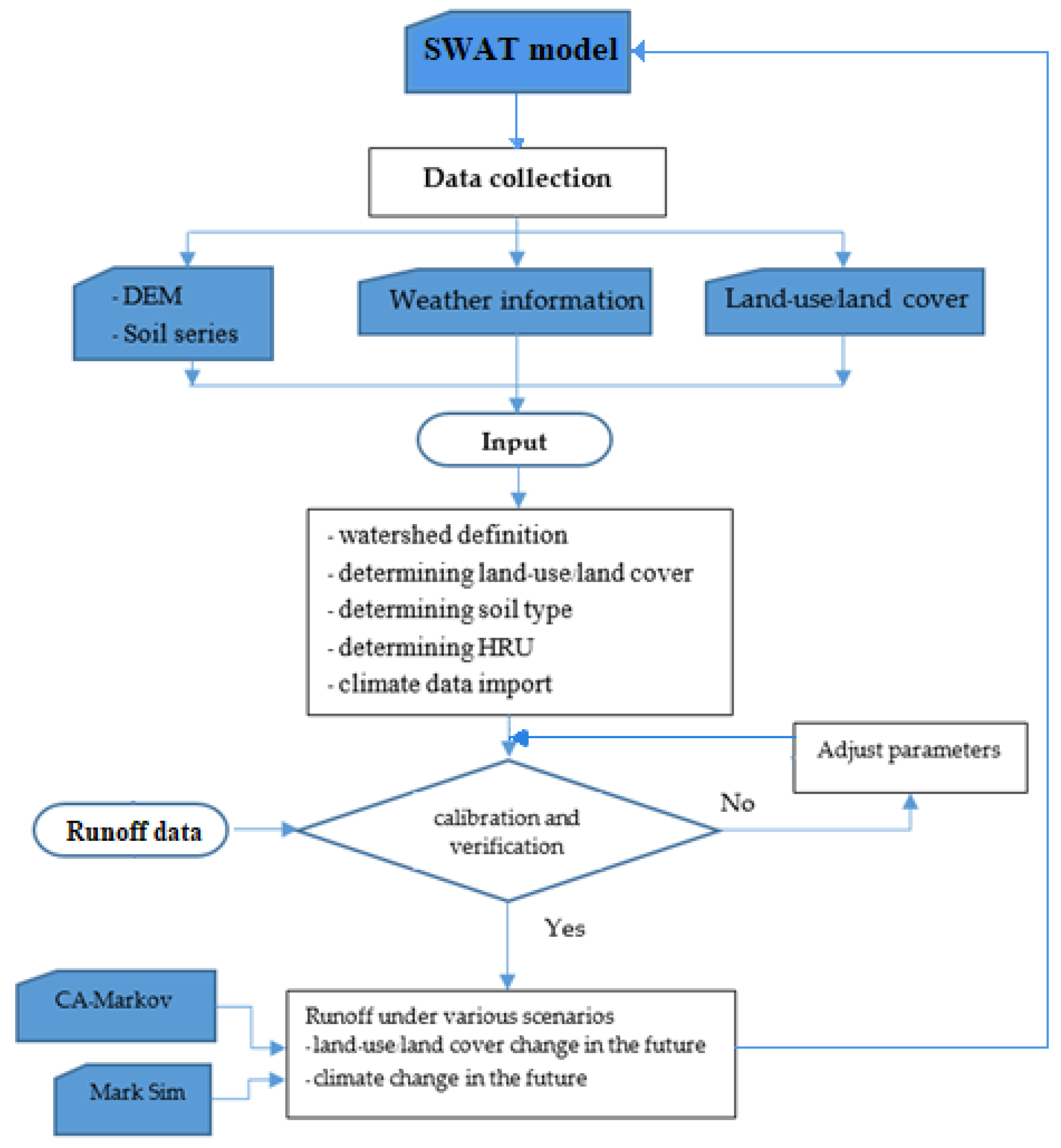
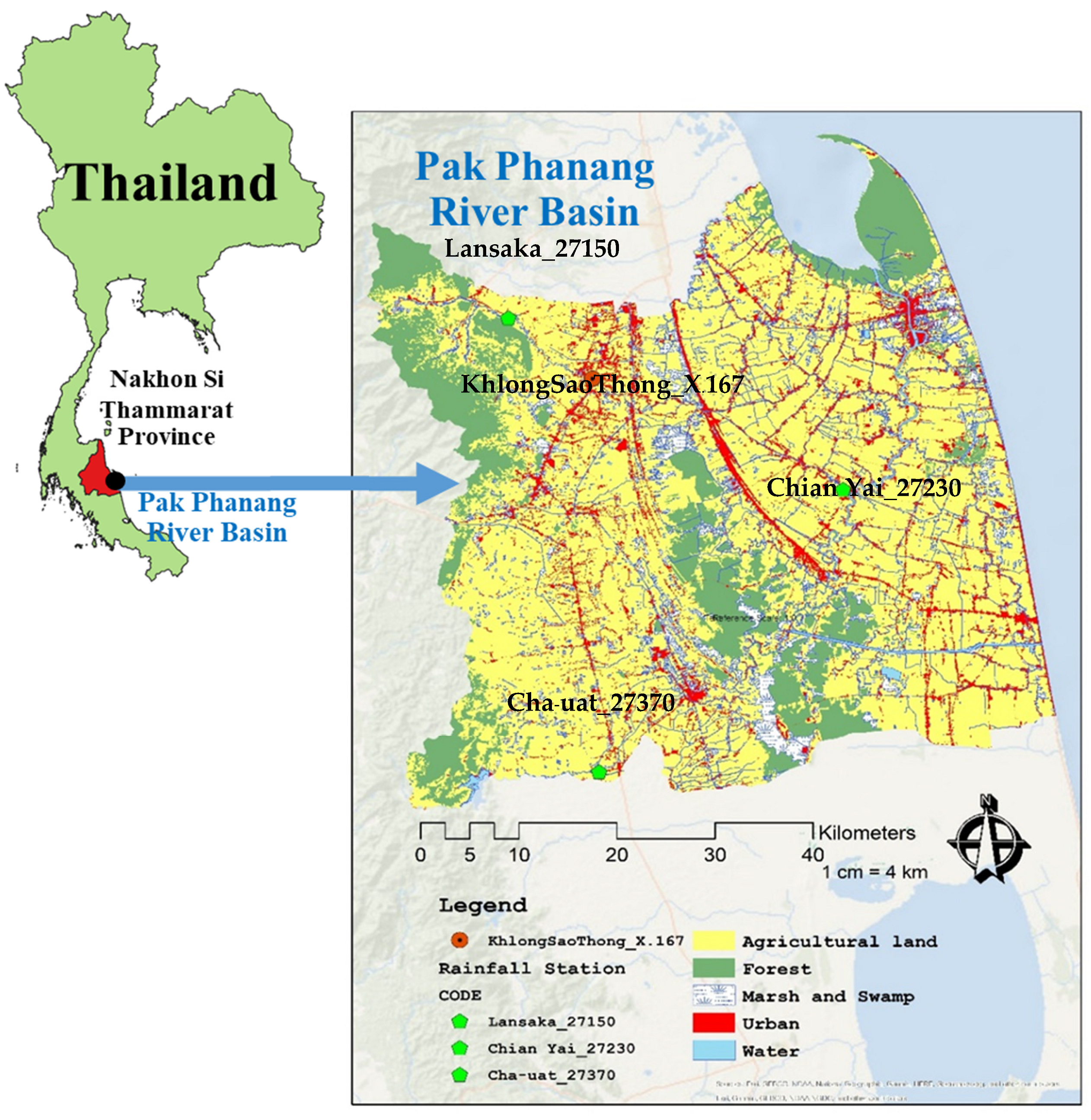
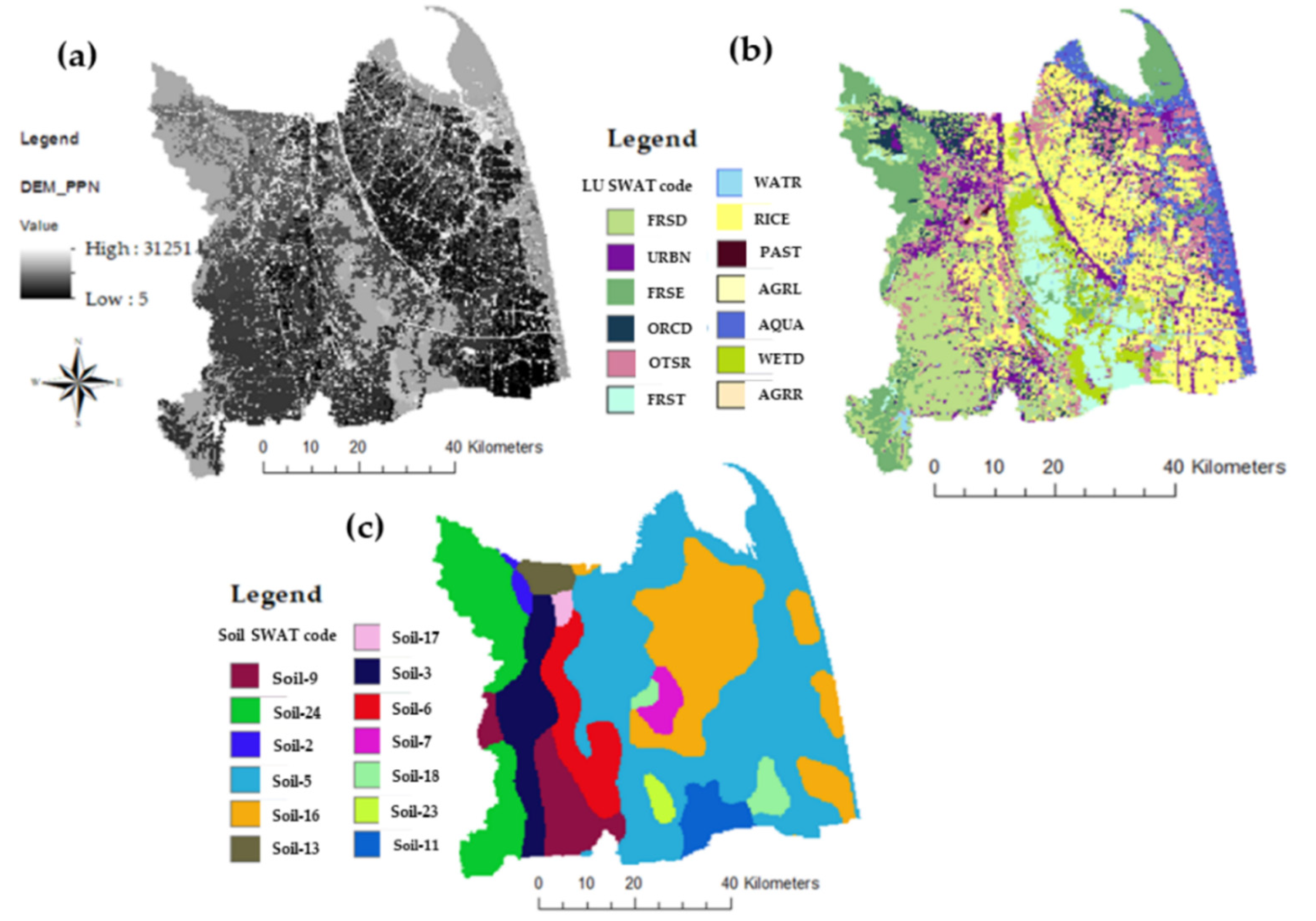
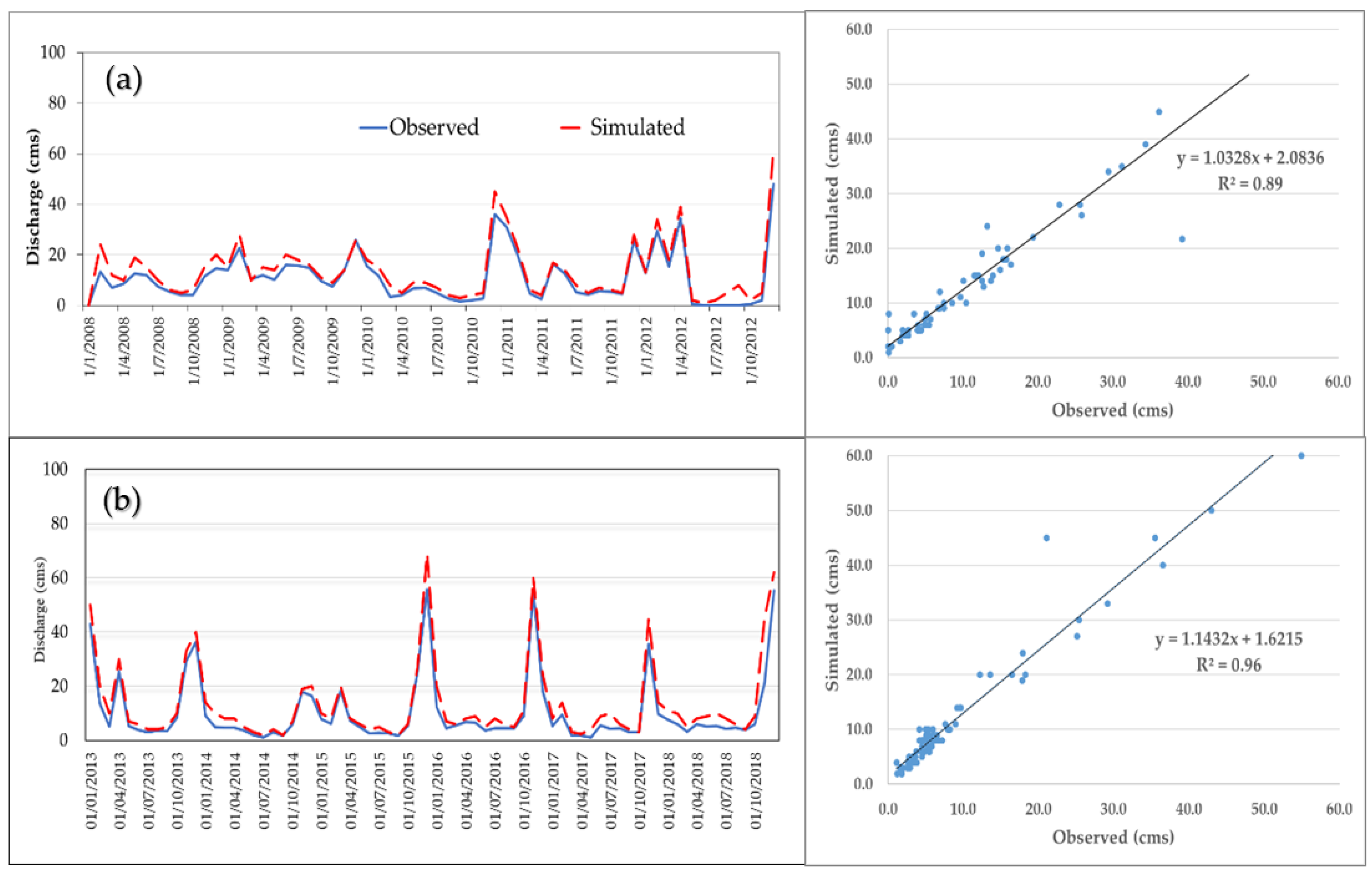
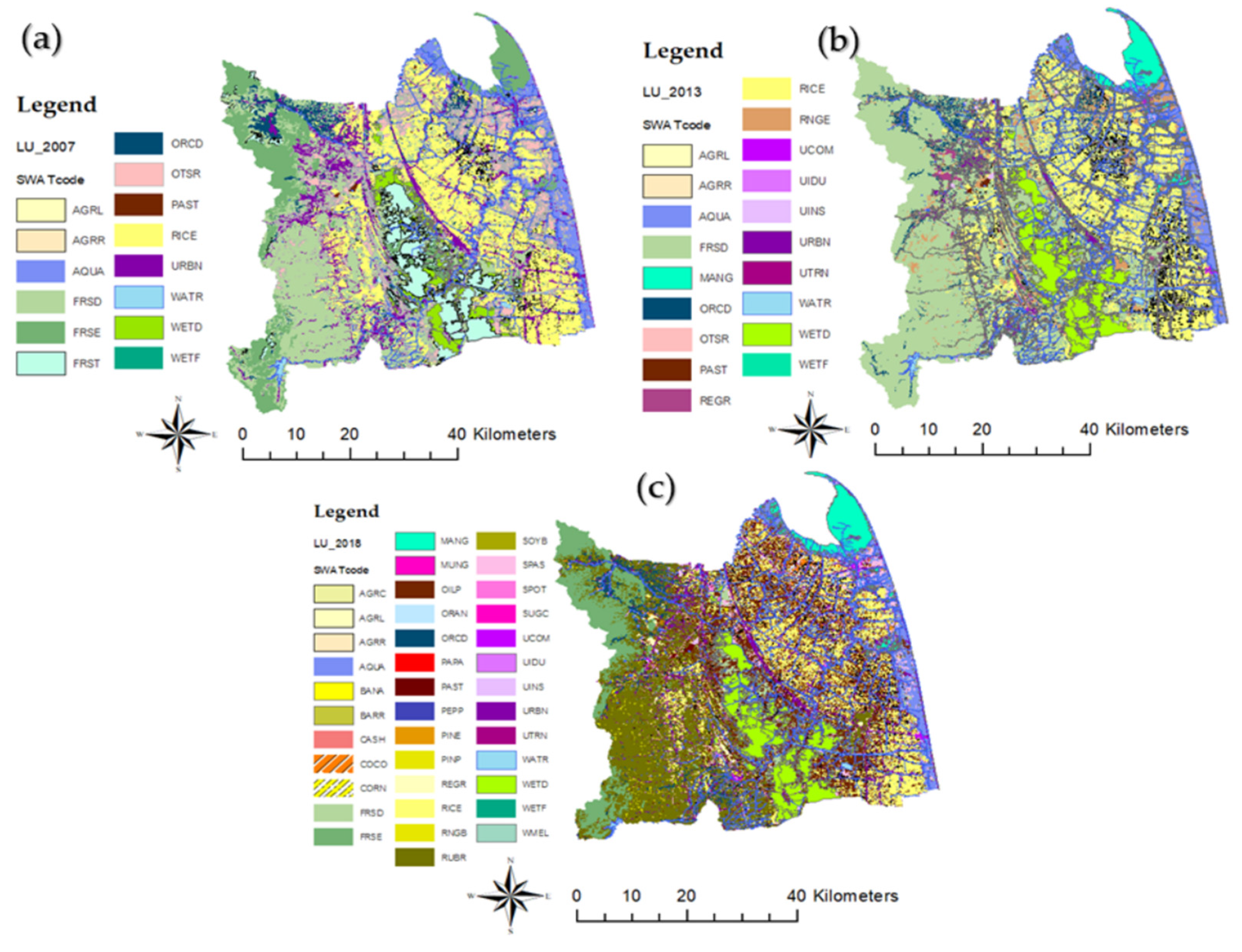


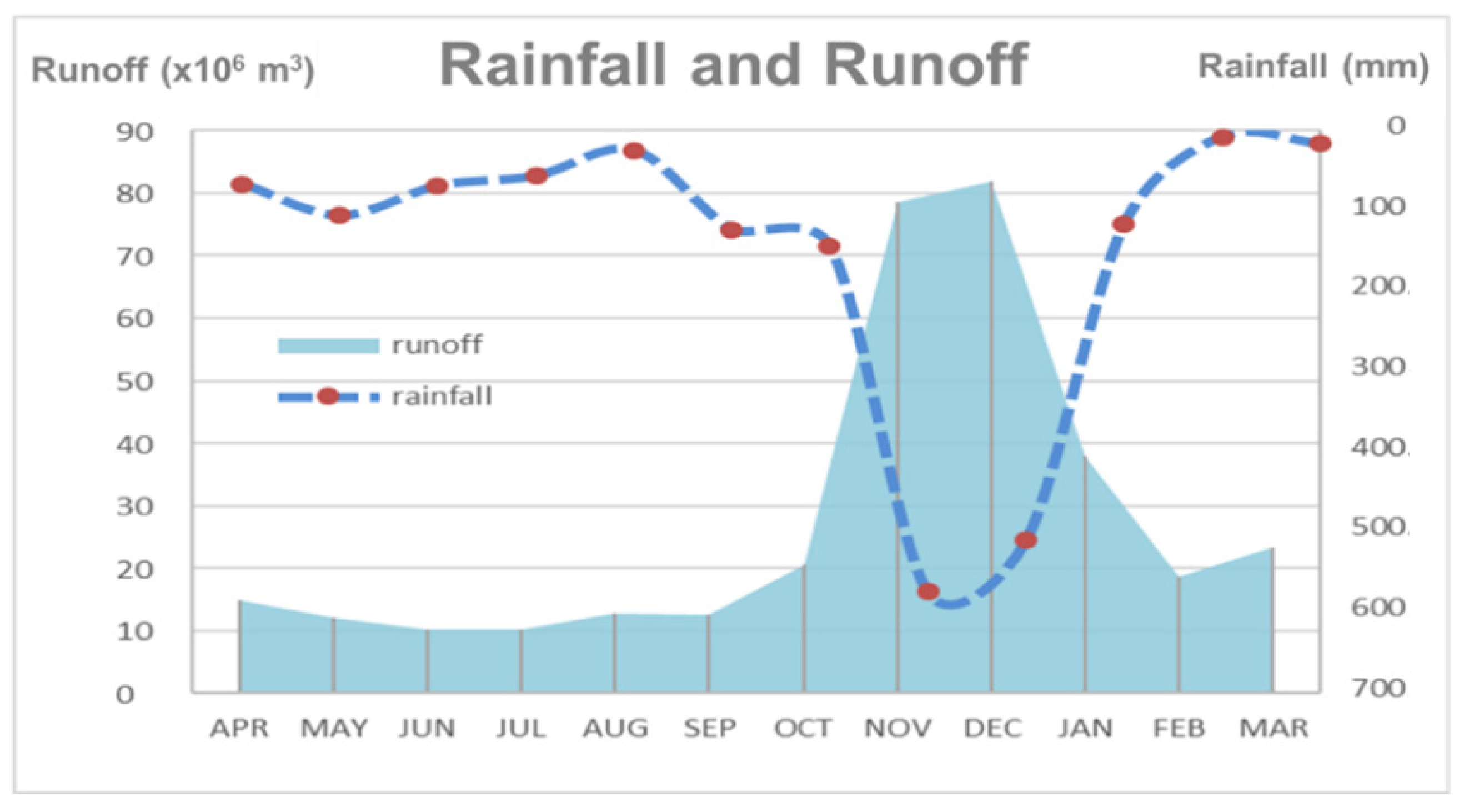
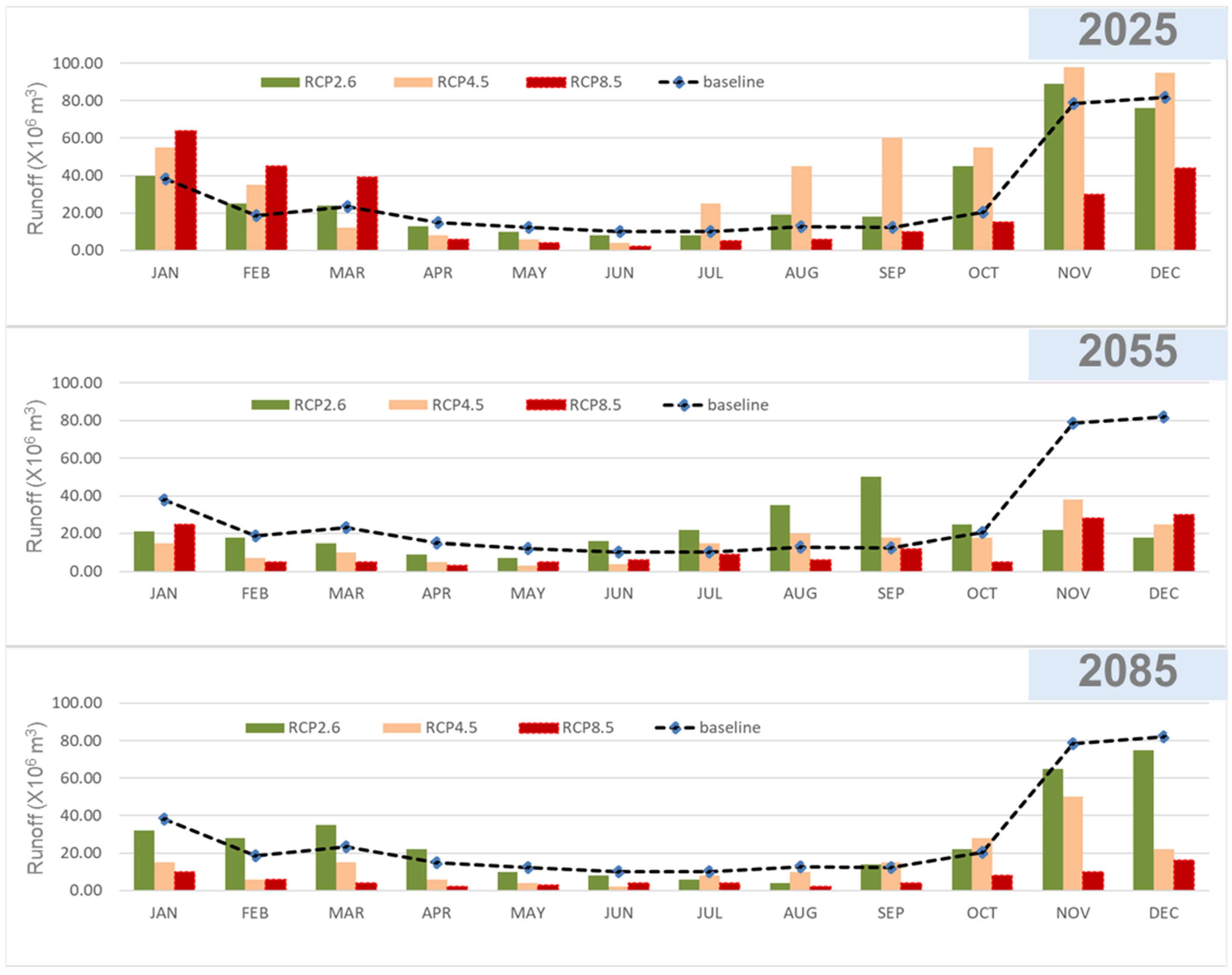
| No. | Models | Resolution | No. |
|---|---|---|---|
| 1 | Beijing Climate Center Climate System Model version 1 (BCC-CSM1-1) | 2.8125 × 2.8125 | Beijing Climate Center, China Meteorological Administration |
| 2 | Beijing Climate Center Climate System Model version 2 with a moderate resolution (BCC-CSM1-1-M) | 2.8125 × 2.8125 | |
| 3 | Commonwealth Scientific and Industrial Research Organisation (CSIRO-Mk3-6-0) | 1.875 × 1.875 | Commonwealth Scientific and Industrial Research Organisation and the Queensland Climate Change Centre of Excellence |
| 4 | First Institute of Oceanography-Earth System Model (FIO-ESM) | 2.812 × 2.812 | The First Institute of Oceanography, SOA, China |
| 5 | Geophysical Fluid Dynamics Laboratory Climate Model version 3 (GFDL-CM3) | 2.0 × 2.5 | Geophysical Fluid Dynamics Laboratory |
| 6 | Geophysical Fluid Dynamics Laboratory Climate Model (GFDL-ESM2G) | 2.0 × 2.5 | |
| 7 | Geophysical Fluid Dynamics Laboratory Climate Model (GFDL-ESM2M) | 2.0 × 2.5 | |
| 8 | Goddard Institute of Space Studies (GISS-E2-H) | 2.0 × 2.5 | NASA Goddard Institute for Space Studies |
| 9 | Goddard Institute of Space Studies (GISS-E2-R) | 2.0 × 2.5 | |
| 10 | Hadley Global Environment Model 2-Earth System (HadGEM2-ES) | 1.2414 × 1.875 | Met Office Hadley Centre |
| 11 | Institute Pierre Simon Laplace-Low Resolution (IPSL-CMSA-LR) | 1.875 × 3.75 | Institute Pierre-Simon Laplace |
| 12 | Institute Pierre Simon Laplace-Mid Resolution (IPSL-CMSA-MR) | 1.2587 × 2.5 | |
| 13 | An atmospheric chemistry coupled version of MIROC-ESM (MIROC-ESM) | 2.8125 × 2.8125 | Atmosphere and Ocean Research Institute (The University of Tokyo), National Institute for Environmental Studies, and Japan Agency for Marine-Earth Science and Technology |
| 14 | An atmospheric chemistry coupled version of MIROC-ESM (MIROC-ESM-CHEM) | 2.8125 × 2.8125 | |
| 15 | Model for Interdisciplinary Research on Climate (MICRO5) | 1.4063 × 1.4063 | Japan Agency for Marine-Earth Science and Technology, Atmosphere and Ocean Research Institute (The University of Tokyo), and National Institute for Environmental Studies |
| 16 | Meteorological Research Institute (MRI-CGCM3) | 1.125 × 1.125 | Meteorological Research Institute |
| 17 | Norwegian Earth System Model (NorESM1-M) | 1.875 × 2.5 | Norwegian Climate Centre |
| RCP | Description |
|---|---|
| RCP2.6 | The radiative forcing peaks at ~3 W/m2 before 2100, and then declines to 2.6 W/m2 (GHGs peak at ~450 ppm CO2eq in 2050, and then decreases). |
| RCP4.5 | The radiative forcing increases to ~4.5 W/m2 before 2100, and then stabilizes at that level (stabilization GHGs ~550 ppm CO2eq). |
| RCP8.5 | The radiative forcing increases to 8.5 W/m2 by the end of 2100 according to high greenhouse gas emissions (GHGs increase to ~1000 ppm CO2eq in 2100). |
| Evaluation Statistics | The X.167 Runoff Measuring Station | |
|---|---|---|
| Calibration | Validation | |
| NSE | 0.82 | 0.86 |
| R2 | 0.89 | 0.96 |
| RMSE | 4.42 | 4.65 |
| Rank | Parameters Name Code | Definition | Min | Max | Relative Sensitivity | Category of Sensitivity |
|---|---|---|---|---|---|---|
| 1 | CN2 | SCS runoff CN for moisture condition II | 40 | 105 | 70 | Very high |
| 2 | ESCO | Evaporation from soil compensation factor | 0 | 1 | 0.55 | High |
| 3 | SOL_AWC | The soil available water capacity (mm/mm soil) | 0 | 1 | 0.85 | High |
| 4 | SLOPE | Average slope steepness (m/m) N | 0.00001 | 0.45 | 0.65 | High |
| 5 | GW_QMN | The depth of water in shallow aquifers to allow for reverse flow. (mm) | 0 | 6000 | 400 | High |
| 6 | SOL_Z | The depth of soil. (mm) | 0 | 4000 | 2000 | High |
| Weather Data | RCPs | Regression Equation | R2 |
|---|---|---|---|
| Maximum temperature | RCP2.6 | y = 1.2457x − 6.973 | 0.8324 |
| (Tmax) | RCP4.5 | y = 1.228x − 6.4131 | 0.8395 |
| RCP8.5 | y = 1.2216x − 6.1705 | 0.8288 | |
| Minimum temperature | RCP2.6 | y = 1.2883x − 6.6096 | 0.7983 |
| (Tmin) | RCP4.5 | y = 1.2727x − 6.2216 | 0.7883 |
| RCP8.5 | y = 1.2572x − 5.8366 | 0.8025 | |
| Rainfall | RCP2.6 | y = 0.9091x − 6.5062 | 0.8410 |
| (Rain) | RCP4.5 | y = 0.9431x − 10.127 | 0.8653 |
| RCP8.5 | y = 0.9143x − 6.9481 | 0.8585 |
| Year | Runoff (×106 m3) | Runoff Change (%) | |||||
|---|---|---|---|---|---|---|---|
| Baseline | RCP2.6 | RCP4.5 | RCP8.5 | RCP2.6 | RCP4.5 | RCP8.5 | |
| 2025 | 27.80 | 31.25 | 41.50 | 22.50 | 12.41 | 49.28 | −19.06 |
| 2055 | 27.80 | 21.50 | 14.83 | 11.58 | −22.66 | −46.64 | −58.33 |
| 2085 | 27.80 | 26.75 | 6.08 | 11.69 | −3.78 | −78.12 | −57.93 |
Publisher’s Note: MDPI stays neutral with regard to jurisdictional claims in published maps and institutional affiliations. |
© 2022 by the authors. Licensee MDPI, Basel, Switzerland. This article is an open access article distributed under the terms and conditions of the Creative Commons Attribution (CC BY) license (https://creativecommons.org/licenses/by/4.0/).
Share and Cite
Janta, R.; Khwanchum, L.; Ditthakit, P.; Al-Ansari, N.; Thi Thuy Linh, N. Water Yield Alteration in Thailand’s Pak Phanang Basin Due to Impacts of Climate and Land-Use Changes. Sustainability 2022, 14, 9106. https://doi.org/10.3390/su14159106
Janta R, Khwanchum L, Ditthakit P, Al-Ansari N, Thi Thuy Linh N. Water Yield Alteration in Thailand’s Pak Phanang Basin Due to Impacts of Climate and Land-Use Changes. Sustainability. 2022; 14(15):9106. https://doi.org/10.3390/su14159106
Chicago/Turabian StyleJanta, Rungruang, Laksanara Khwanchum, Pakorn Ditthakit, Nadhir Al-Ansari, and Nguyen Thi Thuy Linh. 2022. "Water Yield Alteration in Thailand’s Pak Phanang Basin Due to Impacts of Climate and Land-Use Changes" Sustainability 14, no. 15: 9106. https://doi.org/10.3390/su14159106
APA StyleJanta, R., Khwanchum, L., Ditthakit, P., Al-Ansari, N., & Thi Thuy Linh, N. (2022). Water Yield Alteration in Thailand’s Pak Phanang Basin Due to Impacts of Climate and Land-Use Changes. Sustainability, 14(15), 9106. https://doi.org/10.3390/su14159106







